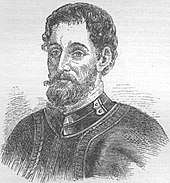Etymology
The word "Tampa" may mean "sticks of fire" in the language of the Calusa, a Native American tribe that once lived south of today's Tampa Bay. This might be a reference to the many lightning strikes that the area receives during the summer months. Other historians claim the name means "the place to gather sticks".[21] Toponymist George R. Stewart writes that the name was the result of a miscommunication between the Spanish and the Indians, the Indian word being "itimpi", meaning simply "near it".[22] The name first appears in the "Memoir" of Hernando de Escalante Fontaneda (1575), who had spent 17 years as a Calusa captive. He calls it "Tanpa" and describes it as an important Calusa town. While "Tanpa" may be the basis for the modern name "Tampa", archaeologist Jerald Milanich places the Calusa village of Tanpa at the mouth of Charlotte Harbor, the original "Bay of Tanpa". A later Spanish expedition did not notice Charlotte Harbor while sailing north along the west coast of Florida and assumed that the current Tampa Bay was the bay they sought. The name was accidentally transferred north.[23] Map makers were using the term Bay or Bahia Tampa as early as 1695.[24]People from Tampa are known as "Tampans" or "Tampanians". Local authorities consulted by Michael Kruse of the Tampa Bay Times suggest that "Tampan" was historically more common, while "Tampanian" became popular when the former term came to be seen as a potential insult.[5] Latin Americans from Tampa are known as "tampeños", or "tampeñas" for females. These terms of Spanish origin emerged after 1900 for the immigrant communities in West Tampa and Ybor City. The tampeño, or "Tampa Latin", community is a mix of Cuban, Italian, Spanish, and American influences, with Cuban influence being dominant.[5][25][26]
European exploration
Not much is known about the cultures who called the Tampa Bay area home before European contact. When Spanish explorers arrived in the 1520s, they found Tocobaga villages around the northern half of Tampa Bay and Calusa villages along the southern portion of the bay.[27]
Extent of Tocobaga culture
In the mid-18th century, events in American colonies drove the Seminole Indians into northern Florida.[28] During this period, the Tampa area had only a handful of residents: Cuban and Native American fishermen.[29] They lived in a small village at the mouth of Spanishtown Creek on Tampa Bay, in today's Hyde Park neighborhood along Bayshore Boulevard.[29]
U.S. control
After purchasing Florida from Spain in 1821, the United States built forts and trading posts in the new territory.[30] Fort Brooke was established in January 1824 at the mouth of the Hillsborough River on Tampa Bay, in Downtown Tampa.[31] Tampa was initially an isolated frontier outpost. The sparse civilian population practically abandoned the area during the Second Seminole War from 1835 to 1842, after which the Seminoles were forced out and many settlers returned.[32]
Fort Brooke circa 1840.
A surviving Ft. Brooke cannon on the University of Tampa campus.
Civil War and Reconstruction
During the Civil War, Florida seceded along with most of the southern states to form the Confederate States of America, and Fort Brooke was manned by Confederate troops. Martial law was declared in Tampa in January 1862, and Tampa's city government ceased to operate for the duration of the war.[36]In 1861, the Union Navy set up a blockade around many southern ports to cut off the Confederacy, and several ships were stationed near the mouth of Tampa Bay.[37][38][39] The Battle of Fort Brooke on October 16 and the Battle of Ballast Point on October 18, 1863 damaged the Confederates, with Union troops destroying Confederate blockade runners.[40] The Civil War ended in April 1865 with a Confederate defeat.
In May 1865, federal troops arrived in Tampa to occupy the fort and the town as part of Reconstruction. They remained until August 1869.
Tampa was a fishing village with very few people and little industry, and limited prospects for development. Tampa's chronic yellow fever epidemics, borne by mosquitoes from the swampland, were widespread during the late 1860s and 1870s, and many residents left.[41]
In 1869, residents voted to abolish the city of Tampa government.[42] The population of "Tampa Town" was below 800 by 1870, and had fallen further by 1880. Fort Brooke was decommissioned in 1883, and except for two cannons displayed on the University of Tampa campus, all traces of the fort are gone.[citation needed]




No comments:
Post a Comment